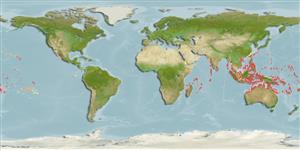Common names from other countries
>
Holocentriformes (Squirrelfishes, soldierfishes) >
Holocentridae (Squirrelfishes, soldierfishes) > Myripristinae
Etymology: Myripristis: Greek, myros, -ou = male of morey eel + Greek, pristis = saw (Ref. 45335).
More on author: Bleeker.
Environment: milieu / climate zone / depth range / distribution range
Ecologia
marinhas associadas(os) a recifes; intervalo de profundidade 1 - 30 m (Ref. 9710). Tropical; 30°N - 23°S
Indo-Pacific: East Africa south to Natal, South Africa and east to the Line, Society, and Tuamoto islands, north to the Ryukyu Islands, south to the Great Barrier Reef. It has not been reported from the Red Sea, Gulf of Aden, Oman, or the Persian Gulf and is absent in the Hawaiian Islands, Marquesas, Pitcairn Group, and Easter Island (Ref. 12419).
Tamanho / Peso / Idade
Maturity: Lm ? range ? - ? cm
Max length : 35.0 cm TL macho/indeterminado; (Ref. 30573); common length : 25.0 cm TL macho/indeterminado; (Ref. 6113)
Espinhos dorsais (total) : 11; Raios dorsais (total) : 14 - 16; Espinhos anais: 4; Raios anais : 12 - 14. Pale salmon pink; edges of scales dorsally on body deep blue to black; median fins with broad black outer border. Inner pectoral fin axil naked except for one (rarely two) moderate scales on lower half (Ref. 2334).
Usually inhabits coral-rich areas of drop-offs and steep channel slopes from below the effects of surge to over 25 m. Occurs singly or in small groups, sometimes with other species (Ref. 9710, 48635). A nocturnal species hiding in caves or beneath ledges by day, feeds on plankton such as crab larvae at night. Maximum depth reported taken from Ref. 128797.
Ciclo de vida ou comportamento de acasalamento
Maturities | Reprodução | Spawnings | Egg(s) | Fecundities | Larvas
Randall, J.E. and D.W. Greenfield, 1996. Revision of the Indo-Pacific holocentrid fishes of the genus Myripristis, with descriptions of three new species. Indo-Pac. Fish. (25):61 p. (Ref. 12419)
Status na Lista Vermelha da UICN (Ref. 130435)
CITES (Ref. 128078)
Not Evaluated
Ameaça para os humanos
Harmless
Uso pelos humanos
Pescarias: pouco comercial
Ferramentas
Relatórios especiais
Baixar XML
Fontes da internet
Estimates based on models
Preferred temperature (Ref.
115969): 25.3 - 29.3, mean 28.5 (based on 2956 cells).
Índice de diversidade filogenética (Ref.
82804): PD
50 = 0.5000 [Uniqueness, from 0.5 = low to 2.0 = high].
Bayesian length-weight: a=0.02089 (0.01313 - 0.03326), b=3.01 (2.88 - 3.14), in cm Total Length, based on LWR estimates for this species & Genus-body shape (Ref.
93245).
Nível Trófico (Ref.
69278): 3.4 ±0.45 se; based on food items.
Resiliência (Ref.
120179): Elevada, tempo mínimo de duplicação da população menor que 15 meses (Preliminary K or Fecundity.).
Fishing Vulnerability (Ref.
59153): Low vulnerability (25 of 100).
